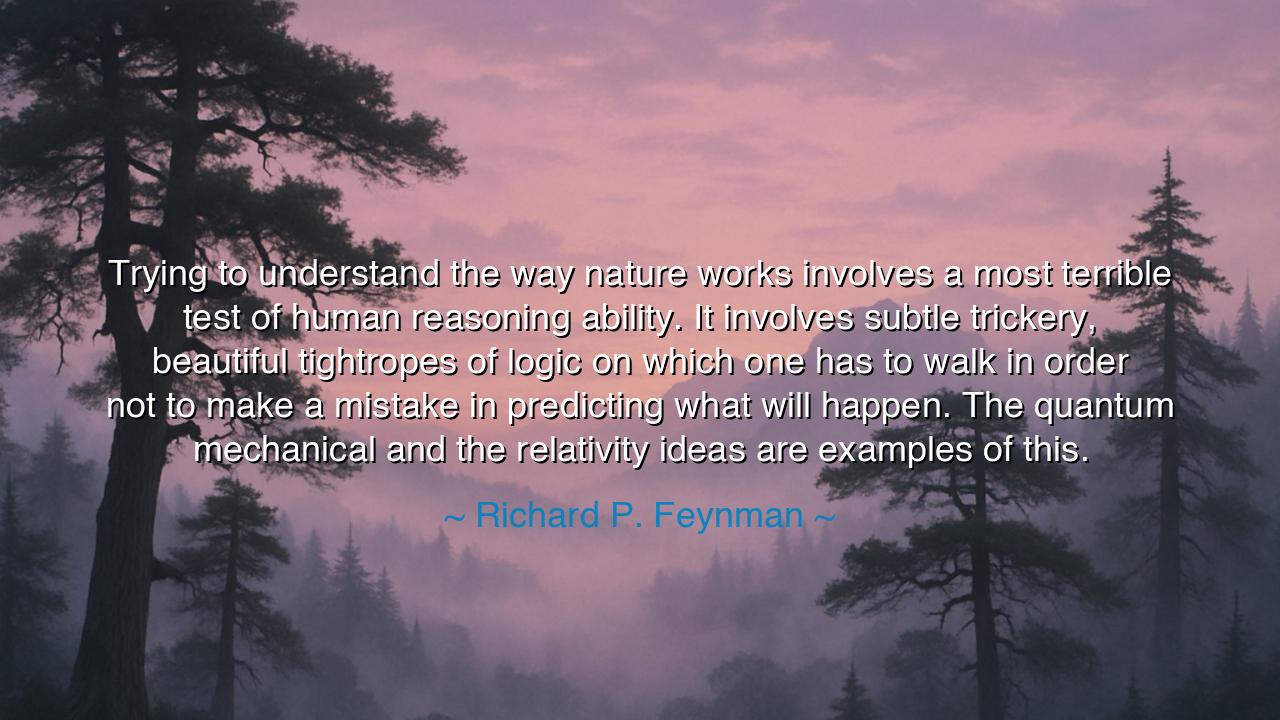
Trying to understand the way nature works involves a most
Trying to understand the way nature works involves a most terrible test of human reasoning ability. It involves subtle trickery, beautiful tightropes of logic on which one has to walk in order not to make a mistake in predicting what will happen. The quantum mechanical and the relativity ideas are examples of this.






When Richard P. Feynman declared, “Trying to understand the way nature works involves a most terrible test of human reasoning ability. It involves subtle trickery, beautiful tightropes of logic on which one has to walk in order not to make a mistake in predicting what will happen. The quantum mechanical and the relativity ideas are examples of this,” he was speaking as both a scientist and a poet of truth. In his words, the human attempt to grasp nature is no simple endeavor, no leisurely stroll in the garden of knowledge. It is a perilous climb across invisible ropes, suspended over abysses of uncertainty. Yet those who dare to tread this path, balancing their reason like a flame in the wind, gain glimpses into the profound mysteries of existence itself.
The origin of this thought lies in the revolution of modern physics. The birth of quantum mechanics and relativity shattered the common-sense view of the world. They revealed that time could stretch, that space could curve, that particles could exist in states beyond comprehension. These were truths so strange that even the keenest minds stumbled. Einstein himself once doubted the completeness of quantum mechanics, calling it “spooky.” Yet through careful reasoning, through the walking of those tightropes of logic, humanity began to map the invisible structure of the cosmos. Feynman, who himself brought clarity to the quantum world with his diagrams and insights, understood the beauty and danger of such intellectual journeys.
History gives us luminous examples of these tests of reason. Consider Galileo Galilei, who turned his telescope to the heavens and discovered moons circling Jupiter. His findings contradicted the prevailing wisdom, forcing him to walk a narrow rope between reason and tradition. To misstep was to invite ridicule or worse, yet his courage to trust the logic of observation gave birth to modern astronomy. Feynman’s metaphor of the tightrope echoes Galileo’s plight: truth lies across a narrow bridge, and only careful reasoning allows us to reach it.
The ancients too glimpsed this truth. Heraclitus declared that “nature loves to hide,” and indeed, her laws are not written in the dust of the earth but in the hidden harmony of opposites. The philosophers of old struggled with paradoxes—the motion of Zeno, the atoms of Democritus, the harmony of Pythagoras. They walked their own tightropes, sometimes stumbling, sometimes soaring, but always testing the reasoning ability of humankind. Feynman, heir to this tradition, knew that in his century the stakes were even higher, for science now touched not only thought but the very fabric of matter and energy.
The meaning of Feynman’s words is both humbling and inspiring. They remind us that human reasoning is fragile when set against the immensity of the universe. A single error in logic can lead us astray for generations. Yet they also remind us that reason, wielded with patience and care, can pierce the veils of the cosmos. The subtle trickery of nature is not meant to discourage us, but to refine us, to sharpen our minds until they are worthy of the truths they seek.
The lesson for us is this: when we seek to understand, whether in science or in life, we must tread with both courage and humility. Do not rush across the tightrope of thought, for haste invites error. Walk carefully, step by step, testing each idea, questioning each assumption. Accept that the path will be difficult, that mistakes will be made, but do not retreat into ignorance. For it is only by enduring the trial of reasoning that we come to behold the beauty of truth.
Practically, we can live this teaching by cultivating patience in thought and discipline in reasoning. Study carefully, question boldly, and do not fear complexity. Whether in science, philosophy, or personal life, strive to balance on the rope between certainty and doubt. Seek clarity, not simplicity, and embrace the wonder of mysteries that stretch beyond immediate comprehension.
Thus, Feynman’s words endure as both warning and encouragement: nature tests the limits of our reason, but in walking the narrow ropes of logic, we grow closer to her hidden heart. To stumble is human, but to persevere is divine. Let us then walk boldly across the ropes of thought, knowing that even in our trembling, we approach the eternal beauty of truth.






AAdministratorAdministrator
Welcome, honored guests. Please leave a comment, we will respond soon